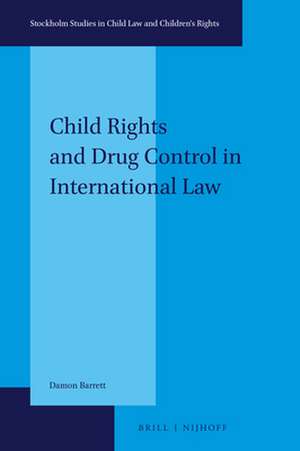Child Rights and Drug Control in International Law: Stockholm Studies in Child Law and Children’s Rights, cartea 6
Autor Damon Barretten Limba Engleză Hardback – apr 2020
Preț: 724.36 lei
Preț vechi: 883.38 lei
-18% Nou
Puncte Express: 1087
Preț estimativ în valută:
138.60€ • 145.10$ • 114.69£
138.60€ • 145.10$ • 114.69£
Carte indisponibilă temporar
Doresc să fiu notificat când acest titlu va fi disponibil:
Se trimite...
Preluare comenzi: 021 569.72.76
Specificații
ISBN-13: 9789004410589
ISBN-10: 9004410589
Pagini: 260
Dimensiuni: 155 x 235 mm
Greutate: 0.48 kg
Editura: Brill
Colecția Brill | Nijhoff
Seria Stockholm Studies in Child Law and Children’s Rights
ISBN-10: 9004410589
Pagini: 260
Dimensiuni: 155 x 235 mm
Greutate: 0.48 kg
Editura: Brill
Colecția Brill | Nijhoff
Seria Stockholm Studies in Child Law and Children’s Rights
Cuprins
Foreword
Pernilla Leviner
Acknowledgements
1 Introduction
1.1 Overview and Context
1.2 Practical and Legal Challenges Relating to Children
1.3 Drugs, International Law and the Convention on the Rights of the Child
1.4 Argumentation and Institutional Practice: a Critical Approach
1.5 Outline and Summary
2 Detachment and Convergence: the History of Child Rights and Drug Control in International Law
2.1 Introduction
2.2 Children and Early Multilateral Drug Controls
2.3 The Bedrock of the System
2.4 Upheaval in the 1960s
2.5 The 1971 Convention
2.6 ‘An Especially Serious Threat to the Youth of the World’: a Change in Tone and the 1972 Protocol
2.7 ‘A Danger of Incalculable Gravity’: the 1988 Convention
2.8 A Human Right: Drugs and the Convention on the Rights of the Child
2.9 Conclusion
3 Fragmentation: the Treaty Framework
3.1 Introduction
3.2 The UN Drug Conventions
3.3 The UN Convention on the Rights of the Child
3.4 The Treaties as Frames of Reference: Complementarity or Conflict?
3.5 Conclusion
4 Contention: the Politics of Article 33
4.1 Introduction
4.2 The Human Rights and Drug Control ‘Positions’
4.3 Thematic Points of Disagreement
4.4 Article 33 and Its Relationship to the Drug Conventions
4.5 Resolution through the VCLT and Conflict Rules?
4.6 Conclusion
5 The Committee on the Rights of the Child: Content, Balance and Normative Framing of Concluding Observations
5.1 Introduction
5.2 Data Collection
5.3 Is a ‘Dialogue’ Taking Place?
5.4 The Content and Balance of Concluding Observations
5.5 Normative Framing
5.6 Conclusion
6 Drug Laws, Policies and Interventions: Monitoring ‘Appropriate Measures’?
6.1 Introduction
6.2 ‘Appropriate Measures’
6.3 Drug Laws and Policies
6.4 Response to Specific Information Raising Human Rights Concerns
6.5 Conclusion
7 Dynamics of Structural Bias
7.1 Introduction
7.2 The Committee’s ‘Preferences’
7.3 Practical Considerations
7.4 Conclusion
8 Conclusion
8.1 The Content of Article 33 and the Relationship between the Regimes
8.2 What Kind of Norm is Article 33?
Annex 1: Content and Structure of the Drug Conventions
Annex 2: Content and Structure of the CRC
Bibliography
Index
Pernilla Leviner
Acknowledgements
1 Introduction
1.1 Overview and Context
1.2 Practical and Legal Challenges Relating to Children
1.3 Drugs, International Law and the Convention on the Rights of the Child
1.4 Argumentation and Institutional Practice: a Critical Approach
1.5 Outline and Summary
2 Detachment and Convergence: the History of Child Rights and Drug Control in International Law
2.1 Introduction
2.2 Children and Early Multilateral Drug Controls
2.3 The Bedrock of the System
2.4 Upheaval in the 1960s
2.5 The 1971 Convention
2.6 ‘An Especially Serious Threat to the Youth of the World’: a Change in Tone and the 1972 Protocol
2.7 ‘A Danger of Incalculable Gravity’: the 1988 Convention
2.8 A Human Right: Drugs and the Convention on the Rights of the Child
2.9 Conclusion
3 Fragmentation: the Treaty Framework
3.1 Introduction
3.2 The UN Drug Conventions
3.3 The UN Convention on the Rights of the Child
3.4 The Treaties as Frames of Reference: Complementarity or Conflict?
3.5 Conclusion
4 Contention: the Politics of Article 33
4.1 Introduction
4.2 The Human Rights and Drug Control ‘Positions’
4.3 Thematic Points of Disagreement
4.4 Article 33 and Its Relationship to the Drug Conventions
4.5 Resolution through the VCLT and Conflict Rules?
4.6 Conclusion
5 The Committee on the Rights of the Child: Content, Balance and Normative Framing of Concluding Observations
5.1 Introduction
5.2 Data Collection
5.3 Is a ‘Dialogue’ Taking Place?
5.4 The Content and Balance of Concluding Observations
5.5 Normative Framing
5.6 Conclusion
6 Drug Laws, Policies and Interventions: Monitoring ‘Appropriate Measures’?
6.1 Introduction
6.2 ‘Appropriate Measures’
6.3 Drug Laws and Policies
6.4 Response to Specific Information Raising Human Rights Concerns
6.5 Conclusion
7 Dynamics of Structural Bias
7.1 Introduction
7.2 The Committee’s ‘Preferences’
7.3 Practical Considerations
7.4 Conclusion
8 Conclusion
8.1 The Content of Article 33 and the Relationship between the Regimes
8.2 What Kind of Norm is Article 33?
Annex 1: Content and Structure of the Drug Conventions
Annex 2: Content and Structure of the CRC
Bibliography
Index
Notă biografică
Damon Barrett is a lecturer at the School of Public Health and Community Medicine at the University of Gothenburg. He is a co-founder of the International Centre on Human Rights and Drug Policy, based at the Human Rights Centre, University of Essex.






